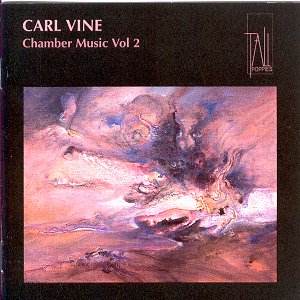This second volume of Carl Vine’s chamber music
concentrates on a period of five years between 1992 and 1997.
Although time has moved on from the music featured in volume
one, which dealt with works from the mid to late eighties,
the Vine hallmarks outlined in my review of the first volume are
still evident here, principally a fascination with rhythm and
rhythmic structures that manifests itself in all of the pieces
featured in some shape or form. Furthermore it is evident that
Vine has continued to consolidate his compositional language with
a consistency and confidence that is not always quite as clear-cut
in volume one.
The Piano Sonata was the highlight if
volume one. Piano Sonata No. 2, here once again played
with considerable panache by Michael Kieran Harvey, was written
partly in response to the success of that first essay. Like the
first, Vine favours a binary structure although here the form
within the two movements takes a slightly different developmental
course. The first movement falls into two clear sections, the
first turbulent and restless, the second more relaxed with bell-like
figurations in the right hand over a form of ground bass in the
left. In the second movement jazzy syncopations dominate, relieved
only by a slower central section in which the same material is
subjected to a dream like transformation. The virtuosity and sheer
headlong pace of much of the writing also harks back to the Sonata
No. 1 and Harvey clearly takes it all in his stride managing
to convey a sense of exhilarating enjoyment at the same time.
The other work for solo piano, this time played
by Ian Munro, is a suite of five fleeting bagatelles that began
life as a one-off piece, Threnody. It was written by the
composer for himself to play at the annual fund raising dinner
of The Australian National AIDS Trust in 1994. Feeling that the
three minute piece could hardly stand alone in its own right,
Vine subsequently added four others, choosing to leave the brief
but moving Threnody to last and framing the suite with
a dark, dream-like nightscape to open and three highly contrasting
central miniatures.
The Sonata for Flute and Piano is an enjoyable
three-movement showpiece that calls for considerable agility on
the part of both players. Despite the fact that five years separate
the Flute Sonata from the Second Piano Sonata
there is a distinct feeling that the material of the opening movement
is not too far away from the sound-world of the solo piano work,
the continuous semiquaver lines on the flute coalescing with the
piano’s florid accompaniment. The appealing slow movement, almost
pastoral in character after a long haunting introduction, explores
a completely different side of the flute’s nature whilst the finale
takes the same basic pulse as the opening movement but transforms
it into a motoric, breathless adrenalin rush to the finishing
post.
The three movements of the String Quartet
No. 3 play continuously and as with a number of Vine’s works
for differing chamber combinations explore contrasting facets
of the instrumental ensemble. The first movement is largely concerned
with the quartet as a whole, the first violin being the only instrument
of note that breaks away from the collective group, subsequently
taking a back seat in the poignant slow movement as the other
instruments all feature in solos against a simple, slow moving
background. Rhythm is once again at the forefront in the final
movement, an aggressive, obsessive moto perpetuo that drives the
quartet to an emphatic conclusion.
The two works featuring electronics represented
in volume one were undoubtedly the weakest on the disc and I was
therefore somewhat cautious approaching Inner World, the
only work on volume two to involve any form of electronics. Here
the solo cello is accompanied by sounds created solely from a
recording of the cello itself and I was pleased to find the result
to be highly effective, the accompanying sounds serving to expand,
develop and diversify the resonance’s of the solo instrument in
a way that can possibly be compared with certain electronic works
by Jonathan Harvey, albeit in a very different musical language.
The slow section commencing from around 8:20 is particularly beautiful
and David Pereira is an impressive and dedicated soloist.
Both of these discs represent a more than useful
introduction to Carl Vine’s music and give clear insights into
his language and style. That said, it is volume two to which I
shall return more frequently, the works represented offering a
greater degree of consistency in terms of their overall quality.
As with volume one, the musicians are all well known to the composer
and once again this familiarity is demonstrated in committed and
authoritative performances.
Christopher Thomas
